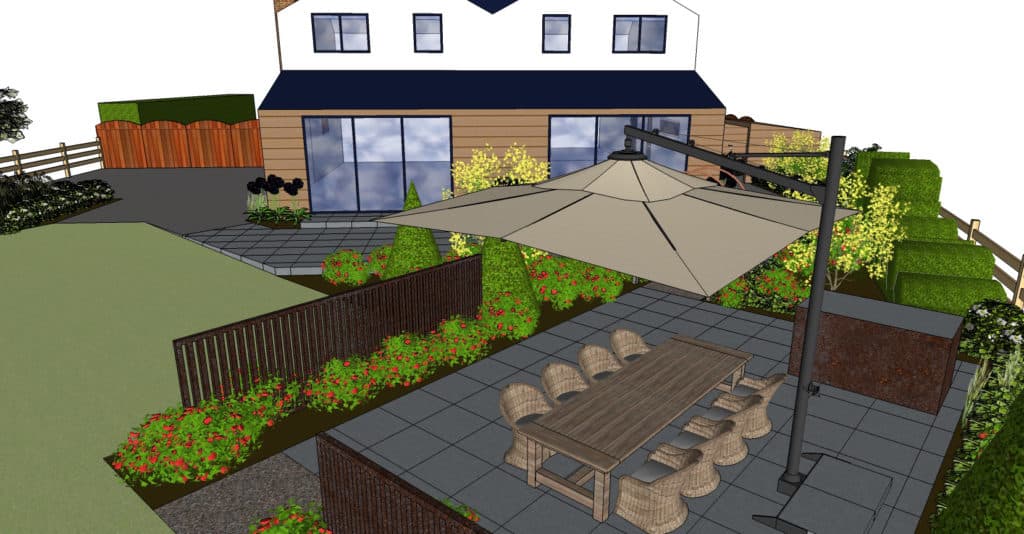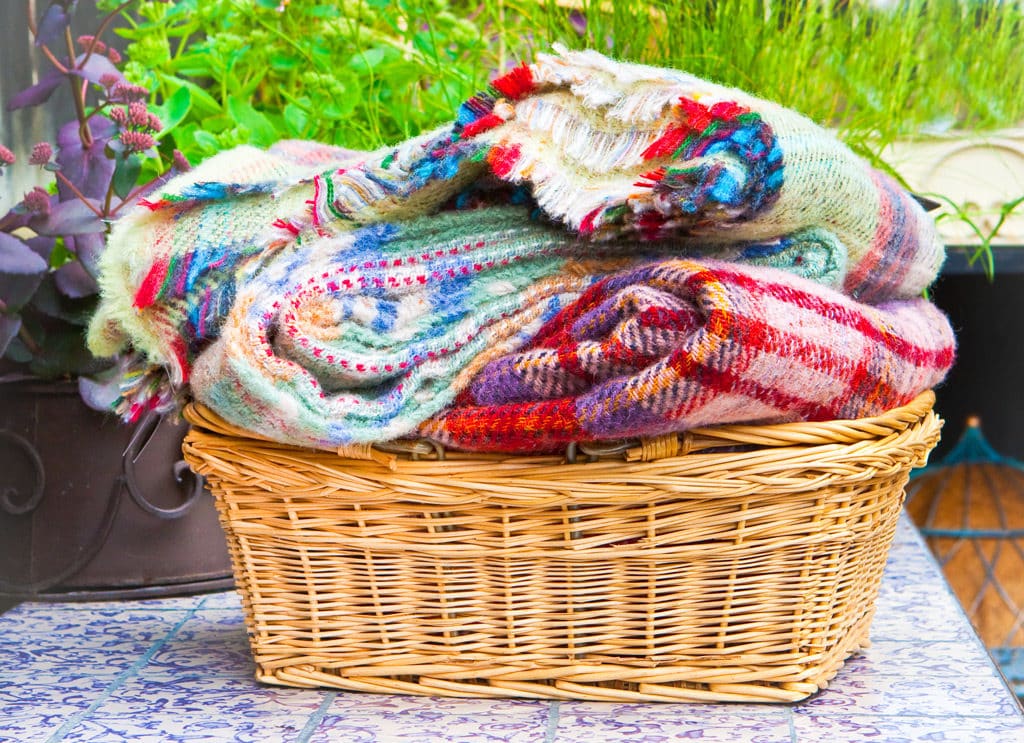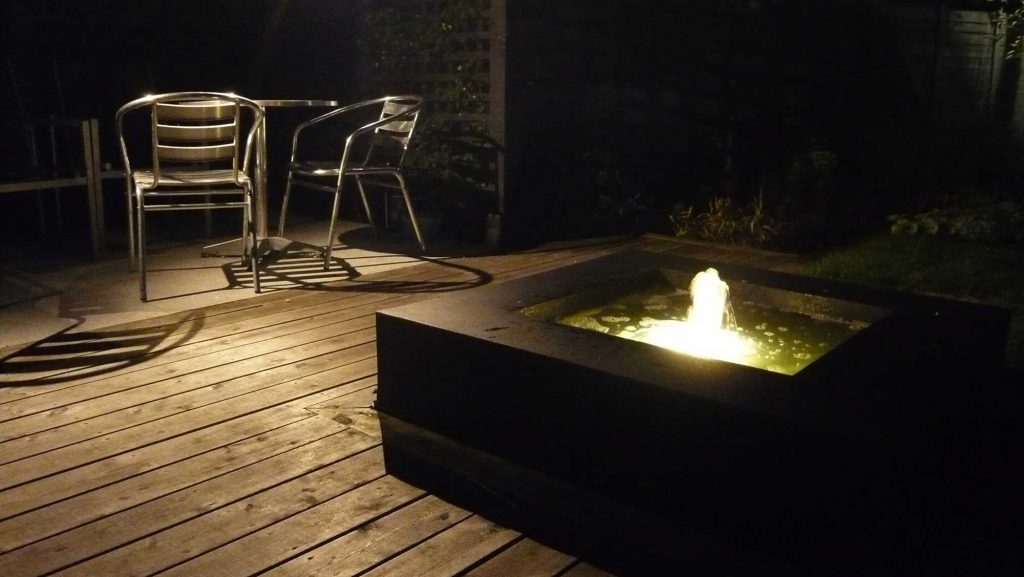21 May Garden Design Tips for creating a fabulous outdoor eating area
In this blog, our Director Paul shares his favourite garden design tips for making sure that your outdoor eating area is a great place to be – whatever the weather.
I like to cook, and entertain outdoors and over the years, I’ve learned a few things about al-fresco eating. I try to weave those lessons into our garden designs so that clients’ gardens are practical as well as beautiful.
- Food tastes better outdoors
- The smell of a barbecue is second to nothing
- Traipsing between the garden and the kitchen for missing ingredients, condiments, desserts and drinks can be a pain
- Sunday brunch cooked and eaten outdoors is like camping – but without the backache, damp clothes or tripping over tent pegs
- It gets chilly when the sun goes down
- The mosquitos in Essex and Suffolk are hardwired to ruin an evening’s entertainment
- Drizzly rain doesn’t stop me having fun, but other people don’t always appreciate it
- Sometimes it gets very dark very quickly. It’s hard to carry plates and glasses back inside when you can’t see where you’re going. Especially if your’re a bit unsteady on your feet.
- The stars are amazing on a clear winter’s evening. Even more so when your hands are wrapped around a mug of hot chocolate.
To really enjoy a garden, the design must have practical features to make it easy to use. Otherwise, it will never reach its full potential for improving its owners’ lifestyle. At Tapestry Design Studios we try incorporate ideas into our layouts and planting plans that will overcome the challenges of outdoor eating and really enhance the pleasurable bits.
This is a typical garden design by head garden designer Katie Moyes. That stylish appearance is built around some very practical features.
Everything you need for outdoor cooking and eating should be close at hand
Kitchen designers work on the principal that everything you need – food storage, preparation areas, sink and cooker should be to hand. When designing an outdoor eating area, we use those principals too.
It’s not always ideal to have the outdoor eating area right beside the kitchen door. An outdoor eating area should make the most of the views from the garden, be sheltered from cold winds and catch the sun. Sometimes that means it is a short distance from the main building.
In this garden, Katie has made sure that the walk from the house to the outdoor eating area is as quick and easy as possible. The parasol in the image hides it, but there is a solid path between the dining area and the house. Katie has recommended using slightly textured paving slabs so they won’t be slippery in damp weather.
Of course, it would be very easy to set up a seating area beside the house too – there’s plenty of choice in this garden.
If possible, its good to build storage, food preparation and serving areas into the design. Cooking and eating outdoors is far more pleasant (and safe) if you can be organised.
A little bit of shelter makes a big difference
Evenings can get chilly in the UK and I don’t know about you but when the conversation is flowing around the table it seems to ruin the ambience if everyone gets up and moves into the house to keep warm.
Screening in the garden can be used to good effect when you want to retain warmth. It offers shelter from the breeze and if there is a fire pit, a warm barbecue or a patio heater on the go, a screen does help to stop the heat escaping. Likewise a beautiful parasol, sail or pergola shades against hot sun during the day and helps to retain warmth in the evening.
In this design, timber screens, a natural hedge and a good quality parasol create quite an intimate area but still allow views over the garden and the landscape beyond.
Good quality patio slabs can retain heat quite nicely too – but it has to be a really warm day in the UK for the effects to be noticeable well into the evening!
A little tip here that I picked up from a marquee wedding reception – have a basket full of blankets to hand. When the temperature dips they can be wrapped around shoulders to keep everyone comfortable for longer. Why not build some storage into your outdoor eating area for useful things like blankets, cushions, citronella candles and matches?
Not all wildlife is welcome but clever planting can help keep pests away
I adore birdsong, I like to hear bees and I think butterflies are amazing. But I don’t appreciate ants at my dinner table any more than I enjoy swatting mosquitoes all night long.
Rather than resort to chemical pesticides, why not use plants to help keep pests at bay.
Mint
Mint is quite a pretty foliage plant with lovely purple flowers in midsummer. There are several different varieties of mint, some of which smell like toothpaste, some like apples, there’s even one that smells like chocolate when the leaves are crushed. But here’s the thing about mint. Ants and flies absolutely hate it.
The thing I like most about mint though is not the aroma, not its insect repelling talents and not the texture of the foliage. It’s the fact that I can pick the leaves to put in my Pimms.
Mint is very easy to grow but can bully other plants – so cultivate yours in a beautiful pot. Spread crushed mint leaves around your outdoor eating area to keep insects and ants away.
Feeling queasy? pop a half a dozen mint leaves into a mug, cover them with boiling water then leave for 5 minutes. Strain the mint tea into a clean cup then sip it slowly.
Fabulous for the morning after a party!
Basil
Basil is an edible herb whose leaves are delicious when ripped up and sprinkled on a tomato salad. It’s also rather good at repelling mosquitos. If the mossies are being a nuisance, rub basil leaves on exposed skin and you’ll reduce the risk of being bitten. Basil isn’t frost hardy in the UK so you will need to replace plants every year.
Lavender
Bees love it but mosquitoes hate it. I think it smells divine when it’s in flower. I’m told that the flowers can be cut and dried then taken indoors and displayed in a vase to scent a room.
Lemon Thyme
When the leaves of lemon thyme are crushed they give off a citrus scent that gnats and mosquitoes really don’t like. If you’re a fan of cottage style gardens you could have a patio with thyme plants growing between some of the slabs so that you release the scent when you walk over them.
Rosemary
Another edible herb that keeps biting insects at bay. Rosemary has pretty blue flowers in May and June that are very attractive to bees. For barbecue chefs, rosemary has another, rather more delicious use. Cut some long rosemary stems and strip off all of the leaves (save them to use in marinades, casseroles or lamb dishes). Now you can use the stem as a kebab stick. Prepare kebabs well in advance and the food will be infused with a wonderful herby flavour. Just be careful not to overload them though – they can be a bit bendy!
Light up the evening
I like an outdoor eating area to remind me of holidays. And for that I need lights. Modern technology means that there are a myriad of different ways to light up the garden. Solar lights are lovely for summer but a bit unreliable in winter. These days it’s neither expensive nor difficult to have lighting built into a deck or a patio. There are even colour changing lights that can be operated from an app on your mobile phone.
You can have so much fun with outdoor lighting these days. I like this gentle, intimate light but you could change the colour, use spotlights to draw attention to other features in the garden or light up the path so that you can weave your way home at the end of the evening
Katie’s concept design doesn’t detail lighting, but trust me, when the garden is built, there will be light. Soft lights around both patio areas and along the path encourage the family to use the garden after dusk and if anyone is a bit wobbly-legged at the end of the evening, it’s easy to find the way back indoors.
I don’t care what time of year it is, you can’t beat a good fire. There’s something about a fire pit that is instantly relaxing. Folks tell me it’s a primeval instinct going back to caveman days. I don’t know about that. I do know that I couldn’t write about designing an outdoor eating area without thinking about toasting marshmallows on the fire.
Imagining your outdoor eating area
At Tapestry Design Studios we do all we can to help you imagine how you could use your whole garden – not just the seating area. This is what Katie’s design looks like when presented using 3D computer technology. Great isn’t it?
Garden Design Tips to Make the most of your outdoor space
Key factors for good garden design
Make the most of a small garden
If you would like help to design an outdoor eating area for your garden, we’d love to help. Contact Tapestry Design Studios by phone or email, or find us on Facebook









Sorry, the comment form is closed at this time.